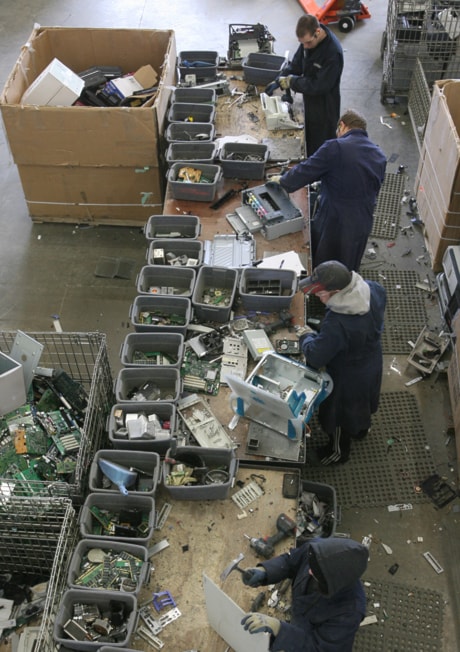Whether you weigh it as material diverted from landfills or manufacturing resources preserved, 37 million pounds is a pretty hefty figure.
In the case of Recycle-Logic Inc., it’s the approximate mass of electronics equipment that’s passed through the Red Deer recycler’s doors since it opened in 2004.
“Initially, I thought our volumes were going to be high at the beginning because everyone would be getting rid of historical stuff that they had already, and then everything would go down,” said Laurie Parsons, the company’s director of operations and co-owner with Todd Burton.
Instead, the quantity of material Recycle-Logic processes has been increasing every year, and currently averages about 250 tonnes a month.
That diverts a lot of plastic, glass and metal from landfills, but also helps preserve the limited supply of raw materials needed to manufacture computers, TVs and other electronic devices, said Parsons.
“There’s only so much copper in the world.”
One of six electronic waste processors registered through the Alberta Recycling Management Authority (the others are in Edmonton, Calgary and Airdrie), Recycle-Logic transports electronic waste from about 80 municipalities between Medicine Hat and High Level.
It also collects from clients like school divisions and businesses, and maintains a drop-off site in Calgary and at its Red Deer premises.
“We do actually get a lot of drop-offs,” said Parsons, who recommends that those who leave computers behind smash the hard drives to protect personal information.
Recycle-Logic opened in March 2004 in anticipation of the launch of Alberta’s electronics recycling program later that year.
Under the program, consumers pay an environmental fee when purchasing new TVs and computer equipment.
Some of the resulting revenues go to electronics waste processors like Recycle-Logic, which also earn money by selling the recyclable materials they strip from the items received.
In addition to TVs and computers, Recycle-Logic accepts such things as answering machines, telephones and cellphones, fax machines, rechargeable batteries, camcorders, CD and DVD players, VCRs, photocopiers and microwaves.
The business currently employs 28, and last weekend moved from its longtime leased premises in Riverside Light Industrial Park to a building at 8075 49th Ave. that it bought. It’s succeeded, said Parsons, through a combination of customer service and low operating costs.
She pointed out proudly that the material Recycle-Logic receives is disassembled manually, with hand tools and rechargeable power tools.
“So we really don’t have a very big impact on the environment.
“My hydro and any of my utility bills are not too much more than my house.”
Parsons attributes the growing volume of discarded electronics to a couple of factors. People are buying more devices than they used to, and tend to replace these more quickly — thanks to advancing technology and declining prices.
Since the electronics recycling program started, more than three million units of computer equipment and TVs have been processed in the province, said Betty Gray, communications manager with Alberta Recycling Management Authority.
The Alberta government is now considering expanding the program so that environmental fees will also be collected from consumers when they buy other electronic devices like stereos, DVD players, fax machines, telephones and small household appliances, said Leanne Behrns, a spokesperson with Alberta Environment.
“At this time, we don’t anticipate extension for this year, but we’re not ruling it out for the future.”
That’s welcome news to Parsons and Burton, who are also pleased with the current high prices of some of the commodities their company sells. But they’re also dealing with challenges, such as rising transportation costs and the strong Canadian dollar, which hits them hard when they sell commodities to American buyers.
“Basically, we have 30 per cent less income on our (U.S.) commodities than we had last year at the same time,” said Parsons.
hrichards@www.reddeeradvocate.com
